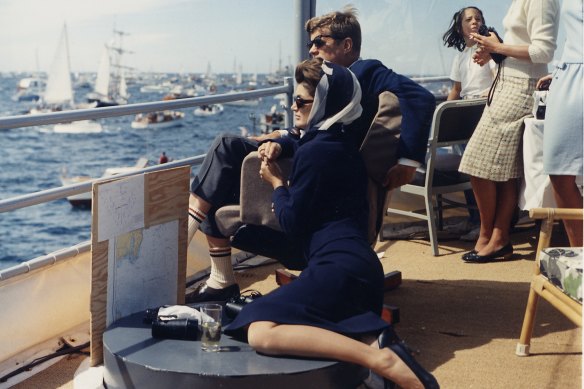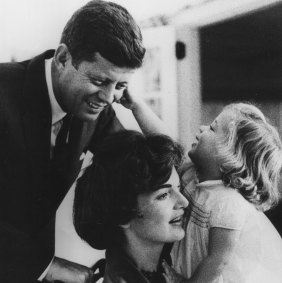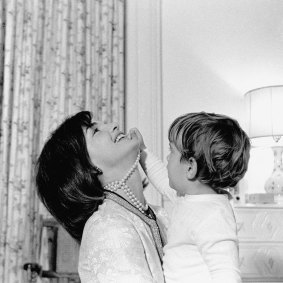This was published 9 months ago
Jackie Kennedy would have turned 95 this week. Who was the woman behind the photos?
By Dawn Tripp
I came to Jackie’s story through a photograph. It’s not a well-known image, but to me, it was striking. A black-and-white photograph of Jackie and Jack, in the summer of 1957, at the airport. Her back is to the camera, her skirt filled with wind, a triple strand of pearls around her neck. She is standing with Jack in a doorway. He leans toward her, perhaps to say something, perhaps to kiss her goodbye.

She was one of the most famous women in the world, but who really was Jackie Kennedy?
It fascinated me – that photograph and the intimacy captured between these two young people. It was clear they had little idea they were being photographed. The moment was private, a faint tension between them, a stiltedness or a longing held in check, something said or left unsaid, and, also, a vulnerability, a tenderness.
I studied this photograph, and to me, it was like fire. Studying that photograph, I wanted to know: What had just transpired between them? What was he just about to say? Who were they together, recently married with all the complex joys and challenges that come with a young love affair?
Over the next few days, I wrote several different passages about the moment captured in the photograph. I wrote longhand, from both Jack’s and Jackie’s perspective. The curious vulnerable intimacy of that image became the heart of the story I wanted to explore.
Looking at the iconic photographs of Jack and Jackie – them on a sailboat before they were married; Jackie holding Caroline as a baby with her little teeth digging into her mother’s string of pearls; Jackie in a white column dress, whispering with Jack in a White House corridor; Jackie and Bobby in the years after Jack was assassinated; Jackie riding her bike alone in Aquinnah – I began to wonder not about the images, but about the moments before and after the image was taken. Those in-between moments of a life.

With JFK and daughter Caroline in 1960, shortly before she became first lady.Credit: Getty Images
I began to seek out images less well known, candids that might not have made the cut for photo essays or the glossy magazines, when she might not have known the camera was on her: a photograph of Jackie dressed in chino shorts rolled up, a white shirt, standing up to her knees in the ocean, and swinging a small Caroline through the surf. Another of Jackie kneeling next to her son, their backs to the camera as they watch Jack leave in a helicopter from the White House lawn. A close-up, blurred-focus snapshot taken by a good friend of Jackie and Jack of them laughing – sunlight on their faces, her hair blown around in the wind.
There was a simple integrity to those images that reminded me of words Jackie herself had once said: “Even though people may be well known, they hold in their hearts the emotions of a simple person for the moments that are the most important of those we know on earth: birth, marriage, and death.”
I was curious to build a narrative out of the things she loved, those things she pursued that mattered to her deeply, that gave her life integrity and meaning. I also began to seek out documentation – both in images and anecdote – of those slightly messy, off-kilter private moments of a life.
As a writer whose first impulse is poetry, I work in the granular. The fragments. I wasn’t interested in the salacious stuff, but rather in peeling away the layers of media and myth and what Jackie herself once called “the river of sludge” to distil the essence of the woman underneath. What she might have been thinking, feeling, what she fought for and believed in. There were so many facets of her – those she projected and those projected onto her: Jackie, Jacks, Jacqueline, Miss Bouvier, Mrs Kennedy, Mrs Onassis, Jackie O.

In the White House with son John jnr, one of those “in-between moments of a life”.Credit: Alamy Stock Photo
Irreverent and fiercely creative, Jackie projected myriad selves but was, at her core, a deeply private person, with a nuanced, formidable intellect. She kept in shape on a trampoline she had placed near her children’s swing set on the lawn outside the Oval Office; she loved art, music, and history; she painted watercolours and read constantly – on boats, on the dock, on the deck, and on the campaign trail.
These slight revelatory fragments illuminated quiet yet irrepressible aspects of Jackie that ran throughout her life. As first lady, (a term she eschewed – “it sounds like a saddle horse,” she once quipped) she was a superior master of harnessing the swirling forces of power around her and wielding influence behind the scenes. In her restoration of the White House, she sought to create the artistic and cultural stage on which her husband’s leadership and vision – grounded in the founding values and democratic ideals of America – could emerge, evolve and rise.
She has been called America’s queen, but in the transcripts of interviews with those who knew her, she is described as down-to-earth, a “firecracker”, a “free spirit”. Her wit was legendary and could be light or scathing, depending on what she felt the moment warranted. A teacher once wrote that she was a “darling child” with a “bit of the devil”, and when JFK was asked by a reporter to capture his wife in a single word, the word he chose was “fey” – unconventional, with an uncanny prescience.
I loved her sense of mischief, her passion for adventure and for the sea. I loved that she bit her nails, read everything, and once remarked that she considered herself “an outsider … a very hard thing to be in American life”.
Irreverent and artistic, she loved the ballet. She’d dog-ear pages in books of philosophy, biography and poetry – lines from Tennyson or Homer that she’d add in pencil in the margins of Jack’s essays and speeches. She had a remarkable capacity to harness language in ways that were persuasive, and often sharp.
Fluent in French, Spanish, Italian, she also spoke some German, and later Greek. She had a lifelong spirit of adventure and was curious to learn about the customs, traditions and histories of the countries where she travelled. She could seem at ease on stage, but perhaps only learnt how to put fame in its place later in her life.
So, who was she underneath the woman we think we see? And what is it that draws us back, again and again, to her story? Remarking on her own photography once, she mused, “The picture is boring if there isn’t something imperfect … something I didn’t catch.”
Is that where the magic lies? In the flaw, in the gap, in what we might always miss? In other words, in the deeply human architecture of a remarkable woman who endured unthinkable, shattering loss and went on to forge a remarkable life? A woman written into myth even as she lived it and who left a quiet legacy of what female power can become.
Jackie (Hachette) by Dawn Tripp is out now.
Get the best of Sunday Life magazine delivered to your inbox every Sunday morning. Sign up here for our free newsletter.